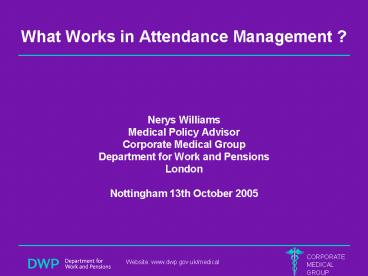What Works in Attendance Management - PowerPoint PPT Presentation
1 / 12
Title:
What Works in Attendance Management
Description:
Sickness absence accounts for 4% of working time, equivalent to 8.4 days for ... model) with active management and intervention (KIT, RTW, case management) ... – PowerPoint PPT presentation
Number of Views:670
Avg rating:3.0/5.0
Title: What Works in Attendance Management
1
What Works in Attendance Management ?
- Nerys Williams
- Medical Policy Advisor
- Corporate Medical Group
- Department for Work and Pensions
- London
- Nottingham 13th October 2005
2
Extent of the Problem
- Sickness absence accounts for 4 of working time,
equivalent to 8.4 days for each employee each
year - Average cost is 601 per employee per year
- One of top 3 concerns of HR professionals
- 50 of organisations use OH to help manage short
term absence, 66 use OH for long term absence - CIPD 2005 absence management 2005 a survey of
policy and practice. Survey Report. London
www.cipd.co.uk
3
Extent of the Problem
- Highest absence levels in food, drink tobacco and
transport - Lowest in consultancy, IT, media and publishing,
agriculture and forestry. - Minor illness is the commonest cause for time
off, second commonest is stress (non-manual) and
back pain (manual) - Trends
- CIPD Employee Absence 2004 reported average 9.1
days off and costs 588 per employee. - Press release quote the most effective
intervention for managing long term absence is
the involvement of OH professionals (60)
4
Extent of the Problem
- 40m working days lost as a result of work related
illness or injury in 2001-2 but this is only a
small proportion of all sick absence HSE
2000-2002 - On any one day 2 of population of working age
absent for health reasons LFS 2001 - The number of people off work because of a health
condition or disability declines with the length
of sickness absence - CIPD, CBI ,EEF 2004 (figs vary but message
the same)
5
Extent of the Problem (DWP perspective)
- 1 million people report sick every week
- 3000 remain off at 6 months
- 2,400 of these will not work again in the next 5
years - 2.7 million people claiming a state incapacity
benefit - DWP Analytical Services 2005
6
Variations in measurement
- ACAS (lost time rate total absence in the
period/ possible total time in the period) X100 - ACAS Absence and labour turnover.
London. ACAS 2003 - NAO office no common definition of sickness
absence, the 15 NHS trusts in Wales have been
using at least 6 different definitions to
calculate their levels of sickness absence,
restricting the extent to what they can compare
their relative performance - The Management of Sickness Absence by NHS
Trusts in Wales. NAO.2004
7
Costs
- Absence costs as of salary bill
- Law firm 1.8
- Insurance co 4.7
- Med retail store 6.8
- Financial svs co. 7.8
- Local authority 8.2
- Large retail store 16.4
8
Evidence
- Anne Spurgeon (IOH) evidence based review
- Anderson K and Norlund A.
- Individuals having the opportunity to influence
their work situation - For back and neck problems better work
satisfaction - Both have a moderate level of scientific
evidence - Scand J Public Health Alexanderson K and Norlund
A. Sickness absence, causes, consequences and
physicians certification practice. A systematic
literature review by the Swedish Council on
Technology Assessment in Health Care. October
2004. - 3. BOHRF Common mental health conditions
9
Evidence
- BOHRF Common mental health conditions
- Prevention
- stress management interventions to give skills
but benefit unclear - Retention
- individual approaches most likely to be
effective for high risk jobs or individuals (but
need to be targeted and applied correctly) - Rehabilitation
- Brief intervention (lt8 weeks) of individual
therapy especially CBT. Computer or face-to-face
(only short term benefits studied)
10
Evidence
- BOHRF Common mental health conditions
- Recommendations for Practice
- Short courses of CBT available
- Course of 4-5 sessions of CBT enhance coping
skills - Supervisors should keep in touch with employees
at least once very two weeks
11
Summary
- Policy
- Ownership
- Early intervention
- Support
- Bio psychosocial approach not just the medical
model) with active management and intervention
(KIT, RTW, case management) - Evaluation and costing
12
Further resources
- HSE/TUC guide on how reps can work with employers
on sickness absence www.hse.gov.uk/sicknessabsence
- HSE Prototype Sickness Absence Recording Tool
- EEF Managing long term sickness absence and
rehabilitation (EEF/IRS survey) tel no 0207 222
7777 - CIPD role of an OH service www.cipd.co.uk
- BOHRF guidelines for common mental health
conditions www.bohrf.org.uk - Institute of Employment Studies
www.employment-studies.co.uk - DWP (desk aids, updates, hot topics)
www.dwp.gov.uk/medical































